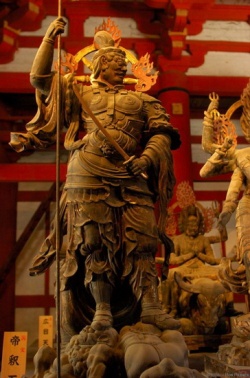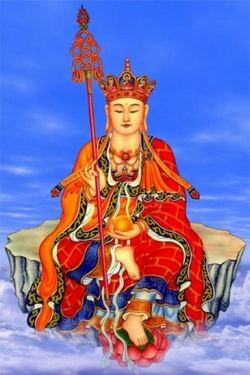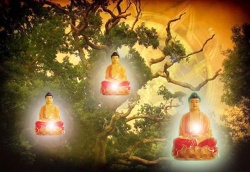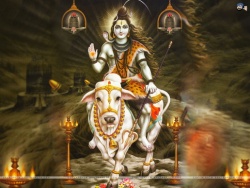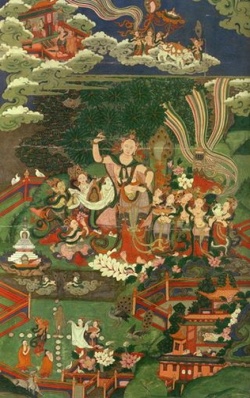Difference between revisions of "Esoteric Buddhism"
(Redirected page to Vajrayana) |
|||
| (15 intermediate revisions by 3 users not shown) | |||
| Line 1: | Line 1: | ||
| − | + | [[File:TojiTemple.jpg|thumb|250px|]]<nomobile>{{DisplayImages|1941|1136|4161|2602|523|4147}}</nomobile> | |
| + | <poem> | ||
| + | [[Esoteric Buddhism]] | ||
| + | [[密教]] ( Jpn [[Mikkyo]] ) [[esoteric Buddhism]] ([[zhen-yan-zong]]) represents both the open teachings of [[exoteric Buddhism]] and the [[secret teachings]] of the [[Buddha]] that are only available to those who have received proper [[initiation]] from a true [[Vajra Master]]. | ||
| + | |||
| + | [[Shakyamuni Buddha]] transmitted these [[secret teachings]] to His [[son Rahula]] and the [[Shambala King]], [[Suchandra]]. He continued to transmit them after His [[death]] to {{Wiki|adepts}} who were able to receive them. | ||
| + | |||
| + | It includes the five divisions of [[esoteric]] [[practice]] ([[mantras]], [[mudras]], [[visualizations]], [[mandalas]], and inner and [[outer tantra]] [[initiation]] or [[empowerment]]) and [[rituals]] as well as the sixth [[division]] of all the [[exoteric teachings]]. | ||
| + | |||
| + | It is not true [[esoteric Buddhism]] if it does not include the teachings of [[exoteric Buddhism]]. | ||
| + | |||
| + | It is sometimes referred to as [[vajrayana]] [[Buddhism]] or [[tantra]]. It includes the [[Lineage]] of the [[Elders]] of the [[Hinayana]], the Profound and Method [[Lineages]] of the [[Mahayana]], and the Practices and [[Blessings]] [[Lineages]] that are unique to the [[Vajrayana]]. | ||
| + | |||
| + | The {{Wiki|Chinese}} [[form]] is called [[Chen-yen Tsung]] while the [[Japanese]] [[form]] is called [[Shingon]]. [[Tibetan]] [[esoteric Buddhism]] offers the [[highest]] [[forms]] of [[practice]]. | ||
| + | |||
| + | See {{Wiki|discourse}} on [[Kalachakra]]. | ||
| + | |||
| + | Also, [[Esoteric teachings]]. Those [[Buddhist teachings]] that are conveyed secretly or implicitly and are held to be beyond the [[understanding]] of ordinary persons. They are defined in contrast to the [[exoteric]] teachings, or those teachings that are explicitly revealed and accessible to all. | ||
| + | |||
| + | According to the [[True Word]] ( Jpn [[Shingon]]) school, the [[Esoteric teachings]] are those teachings that [[Mahavairochana]] [[Buddha]] {{Wiki|preached}} secretly to [[Vajrasattva]], who compiled them and sealed them in an {{Wiki|iron}} tower in southern [[India]]. | ||
| + | |||
| + | The school holds that they contain the [[enlightenment]] of [[Mahavairochana]] [[Buddha]], which is said to be beyond ordinary understanding. | ||
| + | |||
| + | The line of [[transmission]] of [[Esoteric Buddhism]] is held to be from [[Vajrasattva]] to [[Nagarjuna]], and then down through [[Nagabodhi]], [[Chin-kang-chih]] (Skt [[Vajrabodhi]]), [[Pu-k'ung]] ([[Amoghavajra]]), [[Hui-kuo]], and finally to [[Kobo]], the founder of the [[True Word school]] in [[Japan]]. | ||
| + | |||
| + | The school also lists eight [[patriarchs]] who upheld [[Esoteric Buddhism]]: [[Nagarjuna]] and [[Nagabodhi]] who spread it in [[India]]; [[Chin-kang-chih]], [[Pu-k'ung]], and [[Shanwuwei]] ([[Shubhakarasimha]]) who introduced and established it in {{Wiki|China}}; [[I-hsing]] and [[Hui-kuo]] who propagated it in {{Wiki|China}}; and [[Kobowho]] brought it to [[Japan]]. | ||
| + | |||
| + | [[Esoteric Buddhism]] in [[India]] was a [[Form]] of [[Tantrism]] that incorporates indigenous {{Wiki|magical}} and {{Wiki|ritualistic}} [[elements]] such as [[symbolic]] gestures ([[mudras]]) and {{Wiki|spells}} ([[mantras]]), as well as diagrams ([[mandalas]]) and the {{Wiki|worship}} of numerous [[deities]]. | ||
| + | |||
| + | |||
| + | [[Shanwuwei]], [[Chin-kang-chih]], and [[Pu-k'ung]] introduced [[Esoteric Buddhism]] to {{Wiki|China}}. [[Kobo]] (774-835), who went to {{Wiki|China}} and studied under [[Hui-kuo]], a [[Disciple]] of [[Pu-k'ung]], brought these teachings to [[Japan]]. | ||
| + | |||
| + | He systematized them as the {{Wiki|Japanese}} [[True Word]] school. | ||
| + | |||
| + | According to this school, the [[Esoteric teachings]] are the three {{Wiki|mysteries}} the [[Mind]], {{Wiki|mouth}}, and [[Body]] of [[Mahavairochana]] [[Buddha]]. [[Mahavairochana]] is believed to be {{Wiki|omnipresent}}, constantly expounding the Law for his [[own]] [[enjoyment]]. | ||
| + | |||
| + | Through the fusion of the common {{Wiki|mortal}}'s [[three categories]] of [[action]] [[Mind]], {{Wiki|mouth}}, and [[Body]] with [[Mahavairochana]]'s three {{Wiki|mysteries}}, [[people]] can understand The [[Buddha]]'s teachings. [[Kobo]] [[taught]] that, by forming [[mudras]] with one's hands, [[Chanting]] [[mantras]] with one's {{Wiki|mouth}}, and {{Wiki|concentrating}} one's [[Mind]] on [[mandalas]] as [[objects]] of [[devotion]], one could become [[identical]] with [[Mahavairochana]] [[Buddha]]. | ||
| + | |||
| + | That is, [[Kobo]] said that the [[practice]] of the three {{Wiki|mysteries}} enabled one to attain [[Buddhahood]] in one's {{Wiki|present}} [[Form]]. [[Thus]] his teachings are referred to as {{Wiki|esoteric}}. | ||
| + | |||
| + | |||
| + | |||
| + | [[Shakyamuni Buddha]], on the other hand, who appeared in this [[World]] as a [[human]] {{Wiki|being}}, expounded his teachings in accordance with the people's capacity. | ||
| + | |||
| + | The [[True Word]] school claims that, because these teachings were expounded explicitly within the reach of the people's [[understanding]], they are to be called {{Wiki|exoteric}} and are {{Wiki|inferior}} to the teachings of the [[transcendent]] [[Mahavairochana]] [[Buddha]]. | ||
| + | |||
| + | [[Esoteric teachings]] were also endorsed by the [[Tendai]] school. | ||
| + | |||
| + | [[Tendai Esotericism]] was developed by [[Jikaku]], the third [[chief priest]] of the [[Tendai]] school, [[Chisho]], the fifth [[chief priest]], and others. | ||
| + | |||
| + | Unlike [[Kobo]]'s [[True Word]] school, [[Tendai Esotericism]] holds that [[Shakyamuni]] and [[Mahavairochana]] are two aspects of the same [[Buddha]]. [[Tendai Esotericism]] [[views]] the [[Three Vehicles]] as [[exoteric]] teachings, and the one [[vehicle]] as the {{Wiki|esoteric}} [[teaching]]. | ||
| + | |||
| + | It classifies such [[Sutras]] as the [[Lotus]] ([[Lotus Sutra]]) and the [[Flower Garland Sutra]] as one [[vehicle]], and therefore {{Wiki|esoteric}}, [[Sutras]]. | ||
| + | |||
| + | Because they do not mention [[mudras]] and [[mantras]], which constitute [[esoteric]] [[practice]], however, those [[Sutras]] are called [[Esoteric teachings]] in {{Wiki|theory}}, while the [[Mahavairochana]] and [[Diamond Crown Sutras]] are called [[Esoteric teachings]] in both {{Wiki|theory}} and [[practice]]. | ||
| + | |||
| + | [[Tendai Esotericism]] claims that, while the [[Lotus]] and [[Mahavairochana Sutras]] are {{Wiki|equal}} in terms of [[principle]], the [[Mahavairochana]] [[Sutra]] is {{Wiki|superior}} in terms of [[practice]]. | ||
| + | |||
| + | |||
| + | |||
| + | A general term for certain [[Buddhist]] schools and practices originally developing in parallel with [[Hindu]] (see [[Hinduism]]) [[tantra]] with mutual influence at a later stage. | ||
| + | |||
| + | It is {{Wiki|distinguished}} from [[exoteric Buddhism]] by its secrecy; rather than being given openly these teachings are available only to students who have received a proper [[initiation]] ([[abhiṣeka]]) from a [[guru]] who stands in a valid [[lineage]] of [[masters]] and [[disciples]]. | ||
| + | |||
| + | Practice will then make use of a number of techniques in which the [[student]] [[visualizes]] a guardian [[Buddha]], [[Bodhisattva]], or [[deity]] with whom he or she has a special relationship established at their [[initiation]], and then realizes his or her [[non-duality]] with that being. | ||
| + | |||
| + | |||
| + | This appropriation of the [[divine]] guardian's role involves the establishment and [[spiritual]] fortification of a special place of [[practice]] and the use of [[ritual]] formulae ([[mantras]]), gestures ([[mudrās]]), and [[visualization]] techniques. | ||
| + | |||
| + | Occasionally, this also makes use of {{Wiki|sexual}} [[imagery]] or actual {{Wiki|ritualized}} {{Wiki|sexual}} practices as a way of harnessing the [[physical]] [[energy]] and the [[feeling]] that one has transcended personal [[boundaries]] and merged with another that come with {{Wiki|orgasm}}. | ||
| + | |||
| + | [[Esoteric Buddhist]] schools, including many [[Tibetan lineages]], [[Chen-yen]] in [[China]], and [[Shingon]] and [[Tendai]] in [[Japan]], claim that these techniques represent a short-cut to [[enlightenment]] and enable one to attain [[Buddhahood]] in this [[lifetime]]. | ||
| + | |||
| + | Many of the techniques are also used for other this-worldly purposes such as weather control and [[healing]]. | ||
| + | |||
| + | |||
| + | </poem> | ||
| + | {{R}} | ||
| + | [http://www.sgilibrary.org/search_dict.php?SearchSelect=dict&p=4&m=1&in=2&q=Enlightenment www.sgilibrary.org] | ||
| + | [[Category:Buddhist Terms]] | ||
| + | [[Category:Esoteric Buddhism]] | ||
| + | [[Category:Shingon]] | ||
| + | |||
| + | [[Category:Tendai]] | ||
Latest revision as of 17:05, 3 November 2015
Esoteric Buddhism
密教 ( Jpn Mikkyo ) esoteric Buddhism (zhen-yan-zong) represents both the open teachings of exoteric Buddhism and the secret teachings of the Buddha that are only available to those who have received proper initiation from a true Vajra Master.
Shakyamuni Buddha transmitted these secret teachings to His son Rahula and the Shambala King, Suchandra. He continued to transmit them after His death to adepts who were able to receive them.
It includes the five divisions of esoteric practice (mantras, mudras, visualizations, mandalas, and inner and outer tantra initiation or empowerment) and rituals as well as the sixth division of all the exoteric teachings.
It is not true esoteric Buddhism if it does not include the teachings of exoteric Buddhism.
It is sometimes referred to as vajrayana Buddhism or tantra. It includes the Lineage of the Elders of the Hinayana, the Profound and Method Lineages of the Mahayana, and the Practices and Blessings Lineages that are unique to the Vajrayana.
The Chinese form is called Chen-yen Tsung while the Japanese form is called Shingon. Tibetan esoteric Buddhism offers the highest forms of practice.
See discourse on Kalachakra.
Also, Esoteric teachings. Those Buddhist teachings that are conveyed secretly or implicitly and are held to be beyond the understanding of ordinary persons. They are defined in contrast to the exoteric teachings, or those teachings that are explicitly revealed and accessible to all.
According to the True Word ( Jpn Shingon) school, the Esoteric teachings are those teachings that Mahavairochana Buddha preached secretly to Vajrasattva, who compiled them and sealed them in an iron tower in southern India.
The school holds that they contain the enlightenment of Mahavairochana Buddha, which is said to be beyond ordinary understanding.
The line of transmission of Esoteric Buddhism is held to be from Vajrasattva to Nagarjuna, and then down through Nagabodhi, Chin-kang-chih (Skt Vajrabodhi), Pu-k'ung (Amoghavajra), Hui-kuo, and finally to Kobo, the founder of the True Word school in Japan.
The school also lists eight patriarchs who upheld Esoteric Buddhism: Nagarjuna and Nagabodhi who spread it in India; Chin-kang-chih, Pu-k'ung, and Shanwuwei (Shubhakarasimha) who introduced and established it in China; I-hsing and Hui-kuo who propagated it in China; and Kobowho brought it to Japan.
Esoteric Buddhism in India was a Form of Tantrism that incorporates indigenous magical and ritualistic elements such as symbolic gestures (mudras) and spells (mantras), as well as diagrams (mandalas) and the worship of numerous deities.
Shanwuwei, Chin-kang-chih, and Pu-k'ung introduced Esoteric Buddhism to China. Kobo (774-835), who went to China and studied under Hui-kuo, a Disciple of Pu-k'ung, brought these teachings to Japan.
He systematized them as the Japanese True Word school.
According to this school, the Esoteric teachings are the three mysteries the Mind, mouth, and Body of Mahavairochana Buddha. Mahavairochana is believed to be omnipresent, constantly expounding the Law for his own enjoyment.
Through the fusion of the common mortal's three categories of action Mind, mouth, and Body with Mahavairochana's three mysteries, people can understand The Buddha's teachings. Kobo taught that, by forming mudras with one's hands, Chanting mantras with one's mouth, and concentrating one's Mind on mandalas as objects of devotion, one could become identical with Mahavairochana Buddha.
That is, Kobo said that the practice of the three mysteries enabled one to attain Buddhahood in one's present Form. Thus his teachings are referred to as esoteric.
Shakyamuni Buddha, on the other hand, who appeared in this World as a human being, expounded his teachings in accordance with the people's capacity.
The True Word school claims that, because these teachings were expounded explicitly within the reach of the people's understanding, they are to be called exoteric and are inferior to the teachings of the transcendent Mahavairochana Buddha.
Esoteric teachings were also endorsed by the Tendai school.
Tendai Esotericism was developed by Jikaku, the third chief priest of the Tendai school, Chisho, the fifth chief priest, and others.
Unlike Kobo's True Word school, Tendai Esotericism holds that Shakyamuni and Mahavairochana are two aspects of the same Buddha. Tendai Esotericism views the Three Vehicles as exoteric teachings, and the one vehicle as the esoteric teaching.
It classifies such Sutras as the Lotus (Lotus Sutra) and the Flower Garland Sutra as one vehicle, and therefore esoteric, Sutras.
Because they do not mention mudras and mantras, which constitute esoteric practice, however, those Sutras are called Esoteric teachings in theory, while the Mahavairochana and Diamond Crown Sutras are called Esoteric teachings in both theory and practice.
Tendai Esotericism claims that, while the Lotus and Mahavairochana Sutras are equal in terms of principle, the Mahavairochana Sutra is superior in terms of practice.
A general term for certain Buddhist schools and practices originally developing in parallel with Hindu (see Hinduism) tantra with mutual influence at a later stage.
It is distinguished from exoteric Buddhism by its secrecy; rather than being given openly these teachings are available only to students who have received a proper initiation (abhiṣeka) from a guru who stands in a valid lineage of masters and disciples.
Practice will then make use of a number of techniques in which the student visualizes a guardian Buddha, Bodhisattva, or deity with whom he or she has a special relationship established at their initiation, and then realizes his or her non-duality with that being.
This appropriation of the divine guardian's role involves the establishment and spiritual fortification of a special place of practice and the use of ritual formulae (mantras), gestures (mudrās), and visualization techniques.
Occasionally, this also makes use of sexual imagery or actual ritualized sexual practices as a way of harnessing the physical energy and the feeling that one has transcended personal boundaries and merged with another that come with orgasm.
Esoteric Buddhist schools, including many Tibetan lineages, Chen-yen in China, and Shingon and Tendai in Japan, claim that these techniques represent a short-cut to enlightenment and enable one to attain Buddhahood in this lifetime.
Many of the techniques are also used for other this-worldly purposes such as weather control and healing.
